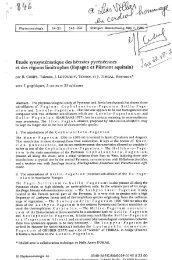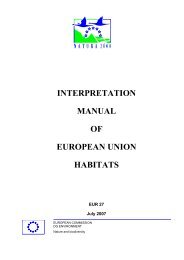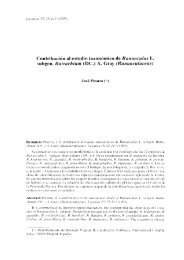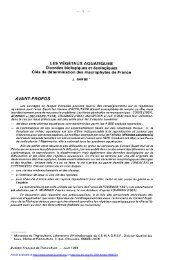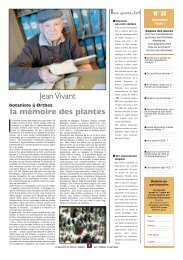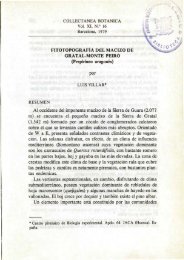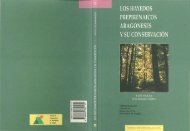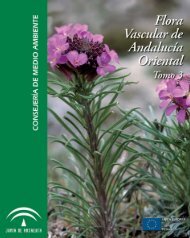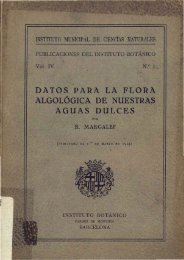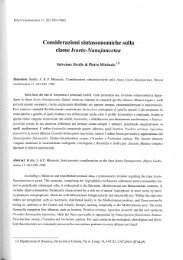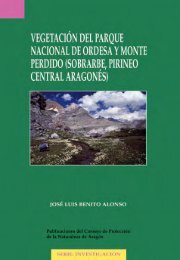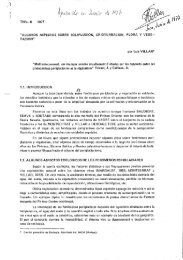Catálogo florístico del Parque Nacional de Ordesa y Monte Perdido ...
Catálogo florístico del Parque Nacional de Ordesa y Monte Perdido ...
Catálogo florístico del Parque Nacional de Ordesa y Monte Perdido ...
Create successful ePaper yourself
Turn your PDF publications into a flip-book with our unique Google optimized e-Paper software.
2. <strong>Catálogo</strong> <strong>florístico</strong> <strong>Catálogo</strong> <strong>florístico</strong> <strong><strong>de</strong>l</strong> <strong>Parque</strong> <strong>Nacional</strong> <strong>de</strong> Or<strong>de</strong>sa y <strong>Monte</strong> <strong>Perdido</strong><br />
LOC.: BH5817: [A] San Úrbez, puente <strong>de</strong> Sangons, 1040 m, LV.<br />
BH5824: [A] entre los bcos. <strong>de</strong> Capradiza y Arrablo, 1355 m, JLB,<br />
PI0308. BH6111: [A] zona baja <strong><strong>de</strong>l</strong> Cañón, 700 m, EBR (31891).<br />
BH6321: [E] inicio <strong>de</strong> la Garganta <strong>de</strong> Escuaín, vistas a Gurrundué,<br />
1400 m, Font & IST, BI0173. YN3926: [O] Turieto Bajo, 1250 m,<br />
PM, LV & Chouard (476770). YN3730: [B] margen <strong>de</strong>recha <strong><strong>de</strong>l</strong> bco.<br />
<strong><strong>de</strong>l</strong> Gabieto, 1370 m, JLB, PI0160. YN4227: [O] Faja Racón,<br />
1400-1800 m, AG & HP (859171).<br />
SECT.: B O T A E P. ALT.: 700 – 1760(1900) m. MPcaduc.<br />
Latesubmed.<br />
Bosques <strong><strong>de</strong>l</strong> piso montano seco, como pinares,<br />
quejigales e incluso carrascales, refugiándose<br />
en altitud en roquedos soleados. Quercion pubescenti-petraeae.<br />
C.<br />
521. Acer monspessulanum L. subsp. monspessulanum<br />
LOC.: BH6211: [A] Fuente <strong>de</strong>ro Baño, 665 m, JLB (R270246).<br />
SECT.: A. ALT.: 665 – 765 m. MPcaduc. Submed.<br />
Novedad para el <strong>Parque</strong> y localidad más<br />
septentrional en el valle <strong><strong>de</strong>l</strong> Cinca. La hemos visto<br />
en la fuente <strong>de</strong> aguas termales <strong>de</strong> la entrada <strong>de</strong><br />
Añisclo, al pie <strong>de</strong> un roquedo calizo húmedo, junto<br />
con otras plantas frioleras. RRR.<br />
112<br />
L. AQUIFOLIACEAE<br />
522. Ilex aquifolium L.<br />
CITAS PREVIAS: PITARD, 1907: 91; CHOUARD, 1928: 961; LOSA &<br />
MONTSERRAT, 1947: 158; VILLAR & MONTSERRAT, 1990: 721.<br />
LOC.: BH5818: [A] frente al bco. Betosa, 1040 m, PM & LV<br />
(36472). BH6518: [E] junto a la pista, 1240 m, Font & IST,<br />
BI0170. BH6029: [P] fondo <strong><strong>de</strong>l</strong> Valle, 1360 m, PM (210490).<br />
BH6030: [P] fondo circo <strong>de</strong> Pineta, 1300 m, PM & LV (255473).<br />
BH7123: [P] bajo Montinier, 1175 m, Vigo, BI0420. YN3528: [B]<br />
junto cámping Bujaruelo, 1215 m, Carreras, BI0293. YN3531:<br />
[B] valle <strong>de</strong> Otal, 1570 m, Carreras, BI0353. YN4227: [O] Faja<br />
Racón, 1400-1800 m, AG & HP (859371).<br />
SECT.: B O T V A E P. ALT.: (750)900 – 1700(1910) m. MPperen.<br />
Lateeur.<br />
PROTECCIÓN: ARA: IV.<br />
El acebo o cardonera forma parte <strong><strong>de</strong>l</strong> estrato<br />
arbustivo <strong>de</strong> hayedos, abetales y pinares. Querco-Fagetea.<br />
Fr.<br />
LI. CELASTRACEAE<br />
523. Euonymus europaeus L.<br />
E. vulgaris Mill.<br />
CITAS PREVIAS: VILLAR & al., 1997: 484.<br />
LOC.: BH5816: [A] San Úrbez, 950 m, DGG (223193). YN32: [O]<br />
Or<strong>de</strong>sa, (VILLAR & al., op. cit.). YN42: [O] Or<strong>de</strong>sa, (VILLAR & al.,<br />
op. cit.).<br />
SECT.: O A. ALT.: 950 m. MPcaduc. Eur.<br />
Orla ± húmeda <strong>de</strong> diferentes tipos <strong>de</strong> bosque.<br />
Prunetalia spinosae. RR.<br />
LII. BUXACEAE<br />
524. Buxus sempervirens L.<br />
CITAS PREVIAS: PITARD, 1907: 89; CHOUARD, 1928: 961; LOSA &<br />
MONTSERRAT, 1947: 178; QUÉZEL, 1956; VASCONCELLOS &<br />
AMARAL, 1960: 134; RIVAS MARTÍNEZ, 1962; FERNÁNDEZ CASAS,<br />
1972; RIVAS MARTÍNEZ, 1987: 164; VILLAR & MONTSERRAT, 1990:<br />
715; RIVAS MARTÍNEZ & al., 1991; PÉREZ GRIJALBO & al., 1993;<br />
ALDEZÁBAL, 1997.<br />
LOC.: BH5819: [A] Cañón <strong>de</strong> Añisclo, 1100-1200 m, PM & LV<br />
(37272). BH5822: [A] bco. <strong>de</strong> San Vicenda, 1150 m, JLB, PI0304.<br />
BH5930: [P] circo <strong>de</strong> Pineta, el Felqueral, 1450-1600 m, LV.<br />
BH6518: [E] junto a la pista, 1240 m, Font & IST, BI0170.<br />
BH6222: [E] La Valle, O Foricón, 1450 m, Font & IST, BI0172.<br />
BH6130: [P] La Larri, 1625 m, JLB, PI0232. BH7023: [P] margen<br />
<strong>de</strong>recha <strong><strong>de</strong>l</strong> Cinca, junto al embalse, 1200 m, JLB, PI0299.<br />
YN3528: [B] entre puente <strong>de</strong> Sta. Elena y ref. Fachaguasa, 1230<br />
m, Carreras, BI0292. YN3731: [B] San Nicolás <strong>de</strong> Bujaruelo,<br />
1400-1800 m, PM & LV (581674). YN4226: [O] Cotatuero,<br />
1500-1600 m, AG & HP (824371).<br />
SECT.: B O T V A E P C. ALT.: 700 – 1900 m. MPperen. Submed.<br />
El boj o bucho es sin duda el arbusto más<br />
abundante y con una ecología más amplia <strong><strong>de</strong>l</strong><br />
Pirineo en suelo pedregoso calizo, pues vive <strong>de</strong>s<strong>de</strong><br />
tierra baja hasta el piso montano superior. Forma<br />
gran<strong>de</strong>s extensiones <strong>de</strong> matorral secundario (bujedos)<br />
<strong>de</strong> diferentes tipos <strong>de</strong> bosque, sólo o mezclado<br />
con el erizón (Echinospartum horridum) y<br />
otros arbustos. También se constituye en vegetación<br />
permanente en lugares <strong>de</strong>scarnados.<br />
Forma parte <strong><strong>de</strong>l</strong> estrato arbustivo <strong>de</strong> carrascales,<br />
quejigales, bosques mixtos, pinares, hayedos<br />
y abetales. Sólo falta en los pinares subalpinos<br />
y bosques más húmedos y fríos. Querco-Fagetea,<br />
Pino-Juniperetea, Quercetea ilicis, Amelanchiero-Buxenion,<br />
etc. CCC.<br />
LIII. RHAMNACEAE<br />
525. Rhamnus alaternus L. subsp. alaternus<br />
CITAS PREVIAS: MONTSERRAT, 1975: 367.<br />
LOC.: BH5816: [A] sobre las Bordas <strong>de</strong> Aso, 1165 m, JLB,<br />
PI0020. BH6212: [A] fuente <strong>de</strong>ro Baño, 650-680 m, PM (16392).<br />
BH6520: [E] Revilla, camino a los miradores, 1200-1250 m,<br />
JLB. YN32: [T] Torla y entrada a Bujaruelo, 1000-1250 m,<br />
(MONTSERRAT, op. cit.).<br />
SECT.: T A E. ALT.: 650 – 1250 m. P(Ch)peren. Med.<br />
Sólo visto en las zonas bajas <strong>de</strong> Añisclo y<br />
Escuaín. Coscojales, bujedos más secos y claros<br />
<strong>de</strong> carrascal. Quercetalia ilicis. R.<br />
526. Rhamnus saxatilis Jacq. subsp. saxatilis<br />
Rh. infectorius L.<br />
LOC.: BH6417: [E] Castillo Mayor, 1450 m, JVF (283490).<br />
YN3826: [O] Parador, 1210 m, JLB (R273690).<br />
CUTM 1×1: BH6015; BH6417; YN3826; YN3827.<br />
SECT.: O A E. ALT.: 1210 – 1450 m. NPcaduc. Submed.<br />
Aquí tiene algunas <strong>de</strong> sus localida<strong>de</strong>s más<br />
septentrionales <strong><strong>de</strong>l</strong> Pirineo.<br />
Arbusto calcícola <strong>de</strong> los márgenes <strong>de</strong> carrascales,<br />
quejigales y <strong>de</strong> los roquedos soleados.<br />
Berberidion. RR.<br />
J.L. Benito Alonso – Institut d’Estudis Iller<strong>de</strong>ncs (2006)



